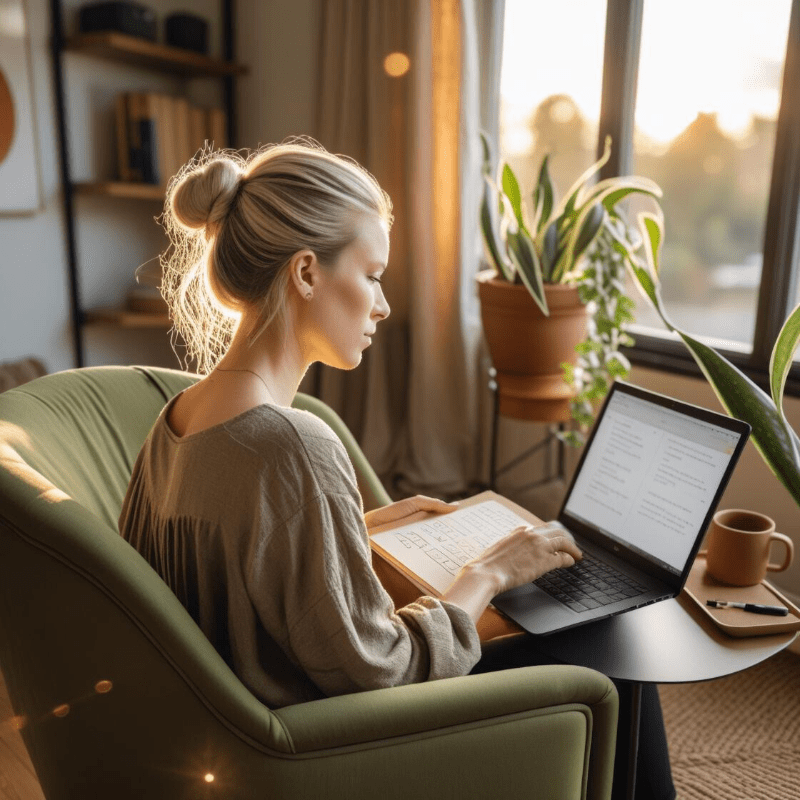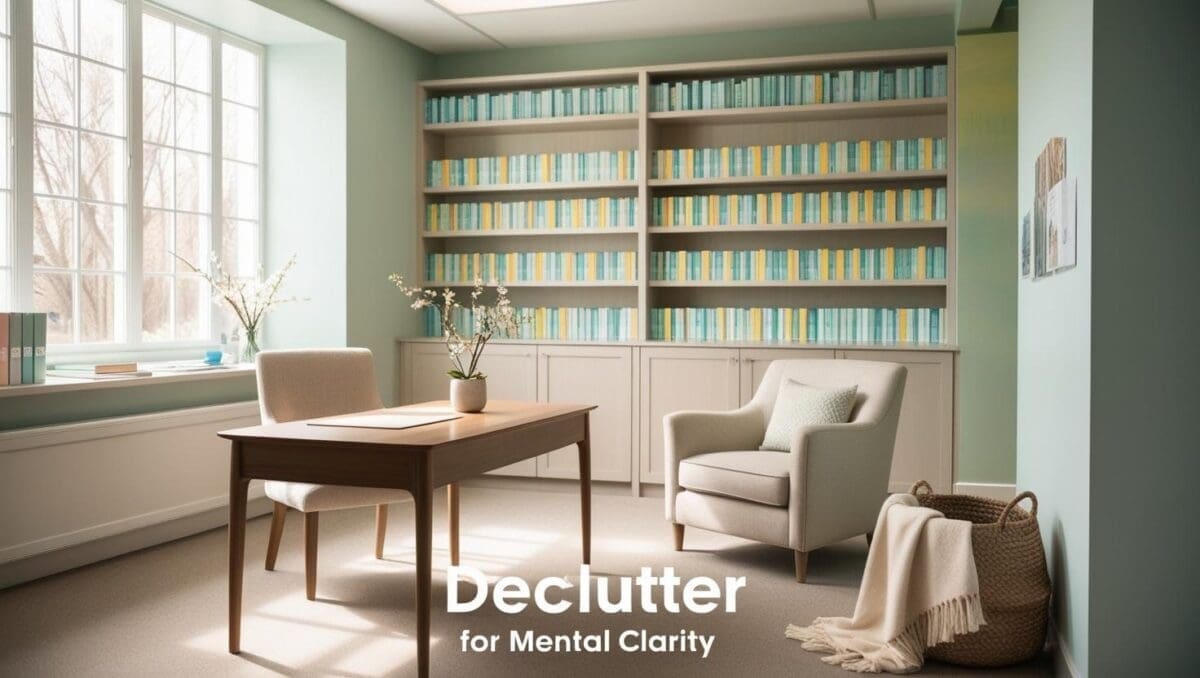When most people think of a therapy office, they imagine bright, airy spaces filled with natural light and soft pastels. However, a thoughtfully designed dark aesthetic can create a unique atmosphere of intimacy, calm, and sophistication. Far from being gloomy, a dark-toned space can feel like a cocoon—a safe, private haven where clients can relax and open up. This guide will walk you through every step of creating a dark aesthetic therapy office, along with creative image prompts that capture the essence of each section.

Why Choose a Dark Aesthetic for Your Therapy Office

Dark tones create an enveloping environment, almost like a cocoon, that fosters emotional safety. They can:
- Encourage Relaxation: Deep colors like navy, charcoal, and forest green have calming effects.
- Exude Sophistication: Dark aesthetics are timeless and can elevate the professionalism of your office.
- Allow Personal Expression: Mixing styles—modern, vintage, rustic—lets you showcase your personality.
Core Styles to Inspire Your Office
1. Modern Minimalism
For those who appreciate clean lines and simplicity, modern minimalism is an excellent choice. Here, dark hues are paired with sleek, uncluttered design elements to create a refined atmosphere.
Elements to Consider:
Accents: Reflective surfaces such as glass tables or polished metal elements to add brightness.
Color Palette: Matte black walls, deep charcoal accents, and hints of cool grays.
Furniture: Minimalist, modern pieces in neutral tones.


- Tip: Use reflective surfaces like glass or polished metal to prevent the space from feeling too heavy.
2. Rustic Charm
If you prefer a warmer, more organic feel, rustic charm might be the way to go. This style integrates dark woods, earthy tones, and natural textures that evoke a sense of comfort and connection with nature.
Elements to Consider:
Lighting: Use natural light and warm, ambient fixtures to soften the depth of dark colors.
Materials: Rich, dark wood for furniture and shelving.
Textures: Rough-hewn materials paired with soft textiles.


- Tip: Incorporate natural light where possible to balance the darker tones.
3. Vintage Luxe
For a touch of elegance and history, vintage luxe infuses the space with a blend of antique elements and modern design. Think velvet fabrics, intricate patterns, and metallic details that add a layer of opulence.
Elements to Consider:
Accents: Metallic finishes such as brass or copper to add glamour.
Color Palette: Deep jewel tones like burgundy, emerald, and sapphire.
Furniture: Antique or vintage-inspired pieces with luxurious upholstery.


- Tip: Use rich jewel tones like burgundy or sapphire as accent colors to enhance the depth of the design.
4. Industrial Chic
Industrial chic combines dark, bold tones with raw, edgy materials. This style embraces exposed brick, metal fixtures, and a mix of rugged and soft textures to create a dynamic and modern environment.
Elements to Consider:
Accents: Bold, minimal decor that emphasizes the industrial edge without overwhelming the space.
Materials: Exposed brick walls and metal lighting fixtures.
Textures: A juxtaposition of hard, industrial surfaces with soft textiles like knitted throws or patterned rugs.


- Tip: Add softer textures like a chunky knit throw or a patterned rug to balance the hard edges.
3. Planning Your Layout: Defining Key Zones
Once you have selected your style, the next step is to plan the layout of your office. Think about how different zones in your space can serve various therapeutic purposes.
A. The Consultation Corner
This is where meaningful conversations happen. A cozy consultation corner should feel intimate and inviting, setting the stage for open dialogue.
Setup Tips:
- Seating: Choose a comfortable chair or small sofa with supportive cushioning.
- Side Table: A small table to hold a lamp, books, or a comforting beverage.
- Decor: Add layers with a soft throw, decorative pillows, and personal mementos that reflect your personality.

B. Display and Shelving Areas
Shelves are not just for storage—they are an opportunity to display elements that inspire calm and creativity. Use these areas to showcase books, decorative items, and personal artifacts.
Setup Tips:
- Arrangement: Mix books, plants, and personal decor to create a balanced display.
- Lighting: Consider small accent lights on shelves to highlight your collection.
- Variation: Use objects of varying heights and textures to add depth and interest.

C. The Statement Wall
A statement wall can serve as a focal point in your office. Whether through bold wallpaper, a gallery of art, or striking photography, this wall should communicate your unique aesthetic.
Setup Tips:
- Artwork: Choose pieces that resonate with your therapeutic philosophy.
- Wallpaper: Consider textured or patterned wallpaper in deep tones.
- Balance: Ensure that the statement does not overwhelm the room; it should complement the overall design.


7. Bringing It All Together
Designing a dark aesthetic therapy office is not about following a rigid set of rules—it’s about blending elements that resonate with your vision and the unique energy of your practice. By choosing the right style, planning your layout with intention, mastering lighting, layering textures, and adding personal touches, you can create a space that is both striking and comforting.
Final Tips:
- Stay Consistent: While mixing styles is encouraged, maintain a consistent color palette and design language throughout the space.
- Embrace Experimentation: Don’t be afraid to rearrange elements until you find the perfect balance between darkness and light.
- Reflect Your Brand: Remember, your office is an extension of your practice. Ensure that every element—from furniture to decor—communicates your commitment to creating a safe, inspiring space for healing.

Closing Thoughts
A dark aesthetic therapy office offers a transformative environment where clients can feel both secure and inspired. By carefully selecting your style—be it modern minimalism, rustic charm, vintage luxe, or industrial chic—and following a step-by-step design process, you create more than just a workspace. You craft a narrative that speaks to professionalism, warmth, and individuality. The detailed image prompts provided here not only serve as a guide for visualizing each element but also as a source of inspiration for every creative decision.
Now is the time to embrace the power of dark aesthetics and design a therapy office that truly reflects your vision. Let your space tell a story of care, creativity, and transformative healing. Your journey toward a unique, engaging, and deeply personal environment begins here.
Frequently Asked Questions
Q: Why choose a dark aesthetic for a therapy office?
A dark aesthetic can create a cozy, intimate environment that promotes relaxation and focus, helping clients feel secure and grounded during sessions.
Q: How can I prevent a dark therapy office from feeling gloomy?
Incorporate layered lighting, use reflective surfaces, and add natural elements like plants to balance the dark tones and maintain a welcoming atmosphere.
Q: What are some popular styles for dark therapy offices?
Popular styles include modern minimalism, rustic charm, vintage luxe, and industrial chic, each offering unique elements to personalize your space.

About the Author
Hi, I’m Eve, a former school counselor with a master’s degree in School Psychology and a passionate advocate for children and families navigating sensory challenges. As a mom of children with sensory sensitivities, I deeply understand the journey special-needs parents face, and I dedicate myself to researching and sharing practical solutions to help children thrive and feel comfortable in their bodies. My goal is also to empower counselors, therapists, and psychologists with creative strategies and supportive resources to enrich their everyday practice. When I’m not writing or exploring new therapeutic approaches, you’ll find me spending quality time with my family and continually seeking inspiration from everyday moments.


